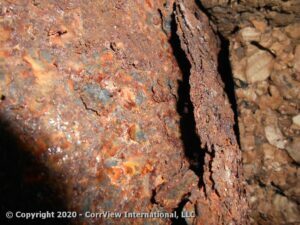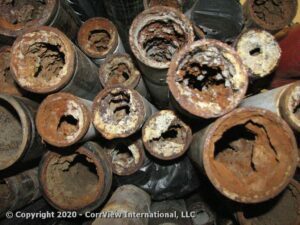Case History: CH-04
Following The Wrong Course
|
A Corrosion Problem Can Provide The Opportunity For Others To Benefit At Your Expense |
-
Preface
A mechanical engineering firm is hired to design a HEPA or high efficiency particulate filter housing around their client’s roof level cooling tower in order to clean the air. The interest of the facility is to stop the capture of airborne dirt and debris which their client believes is interfering with process equipment served by the open condenser water system. Three large sand filters have been installed, with the filter room being expanded to accommodate additional filtration units.
The engineering firm recognizes the difficulty of filtering the enormous volume of air pulled through multi-cell cooling towers serving nearly 2,000 tons of refrigeration, and questions the need for such unusual measures never before encountered in the HVAC field. Subsequently, the engineering firm recommends a piping survey to determine whether corrosion may be responsible for any of the debris causing the operation problems to the facility. An Internet search leads to CorrView International, LLC, who are brought into the project.
-
Investigation
Testing immediately identifies severe corrosion activity exceeding 25 mils per year (MPY). Our finding of very deep pitting to near 0.075 in. suggests that tuberculation and high under deposit corrosion exists. Results clearly suggest that a high corrosion condition and not atmospheric dirt and dust captured by the cooling tower is responsible for the operational shutdowns. A thorough ultrasonic investigation throughout the entire facility shows the smaller pipe of 6 in. and below so severely deteriorated that they now require replacement. Larger pipe can likely be saved by the effective removal of the internal rust deposits followed by a more effective chemical water treatment program.
A conversation with building engineering personnel shows immediate resistance; their having already determined that airborne dirt is the cause of their clogged cooling lines. Building engineers are not cooperative with the ultrasonic investigation and provide no assistance either in the form of providing ladders, opening doors, helping us navigate the facility, or by providing any information about their operation. Further investigation shows that there is no chemical treatment program in place other than a chlorine feed and monitoring panel. There is an incubator and supplies for identifying microbiological activity but no standard chemical test kits.
Piecing together small pieces of information, we learn that the facility had abandoned its chemical treatment program years prior due to what it considered a too high annual expense. Subsequently the facility was struck by Legionaires Disease resulting in some employees being hospitalized. Lawsuits resulted. Experts called in due to the Legionaires outbreak then recommended an automatic feed of liquid chlorine and the continued maintenance of high chlorine residuals which continued long after the Legionella problem had been removed. With highly corrosive concentrated chlorine injected into the steel piping system and no chemical corrosion control for 2-3 years, corrosion rates skyrocket to produce the interruptions of their process equipment.
Further experts called upon recommend high efficiency sand filtration. This action reduces the turbidity of the water by removing the smallest colloidal particles and is rated highly successful, although massive volumes of iron oxide rust product still remain within the system. Following additional process interruptions due to deposits clogging the smaller diameter cooling lines, additional filtration is recommended and installed. All three massive sand filtration units are found having their suction inlet lines tapped into the top 12 o’clock position of one header pipe – thereby almost totally eliminating any useful function. At this top center location, only the smallest particles of lightest mass will be captured by the filtration units, while the main problem remains along the bottom of the pipe. Obviously, this is a poor location for a filtration take-off if one wants to clean a piping system, but an excellent location where justifying the need to purchase additional filtration units is the main interest.
A full overall assessment of the facility shows that a failure to follow standard building maintenance and chemical treatment operations and common sense, in favor of salesmen driven recommendations, resulted in the destruction of a major component of their piping infrastructure. Their problem never had to do with airborne dirt as they adamantly believed, but due to the lack of proper chemical treatment. In essence, the facility was dissolving its pipe into iron oxide by continuously feeding concentrated liquid chlorine, and then filtering some of their pipe out and flushing it down the sewer. And finally, contractors recommended filtering the air serving the cooling towers.
Each outside consultant becoming involved in the problem seemed to have been motivated primarily by furthering their own sales, rather than to solve a relatively simple problem.
-
Conclusion
Our final report on the subject property stops all plans to filter the air to the cooling tower, and results in major pipe replacement. A water treatment program is installed and the chlorine feed discontinued. CorrView International, LLC also recommends creating a closed condenser water loop to the critical production equipment through the installation of a plate and frame heat exchanger, and to increase chemical treatment levels.
© Copyright 2023 – William P. Duncan, CorrView International, LLC





















